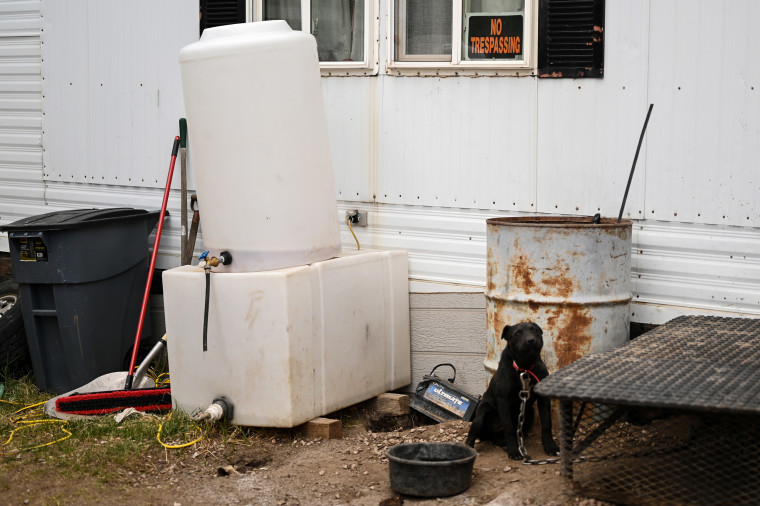Many mobile home park residents in Colorado are afraid to drink the water
Many mobile home park residents in Colorado are afraid to drink the water NBC News


Retired Army Veteran Faces Water Contamination Issues in Elephant Rock Mobile Home Park
PALMER LAKE, Colo. — Every day, retired Army veteran Donald Simmons must make a decision: pay $5 to shower at the nearest truck stop or risk taking a shower at home in contaminated water.
Lately, he has been reluctantly showering at the house, but he refuses to drink the tap water, fearing it will jeopardize his long-term health.
“It could cause cancer. Nobody knows what’s going on,” said Simmons, 68. “You have to shower.”
Simmons has lived at Elephant Rock Mobile Home Park, a small community about 25 miles south of Colorado Springs, for 13 years, and state officials say its water quality violations date back 15 years.
The two private groundwater wells that provide water to Elephant Rock contain high levels of radium, a cancerous radioactive metal, according to state officials.
Water Quality Issues in Colorado’s Mobile Home Parks
Elephant Rock’s woes are part of a larger problem at Colorado’s 800-plus mobile home parks, where water and private wells have been under-tested for decades, said state legislators who have regularly received complaints about smelly, discolored water that tastes bad and could be hazardous to residents’ health.
While no data is available to show how widespread the issue is, some legislators said the complaints they’ve received make them believe many mobile home parks don’t meet federal drinking water standards. Until recently, the state didn’t require testing.
“We don’t know other than what residents are telling us,” said state Rep. Andrew Boesenecker, a Democrat from Fort Collins. “There are pieces that are alarming to anybody, like taste and odor, and where you wouldn’t want to put your kids in the tub at night.”
Low-Income Residents Affected by Water Contamination
Many mobile home park residents have sought help from the Colorado Poverty Law Project, a nonprofit organization that works to prevent homelessness, the project’s deputy director, Jack Regenbogen, said.
“We’ve heard from residents that the water is pretty much undrinkable,” Regenbogen said. “We’ve seen pictures of brown water.”
He said many residents of mobile home parks have low incomes and are afraid to file water contamination complaints out of fear they will be evicted from the only homes they can afford. The median rent in Colorado is $2,200 a month, accordinging to Zillow. In comparison, rent at mobile home parks can be as low as $600 a month.
Complaints and Concerns
Records from the Colorado Department of Public Health and Environment show that residents from about 15 mobile home parks have filed 37 complaints since tracking began in March 2020. The complaints cite illness, discoloration, bad taste and failure by park owners to notify residents of poor water quality.
Parks where residents have complained include Mountainside Estates in Golden, Peak View Park in Woodland Park and Elephant Rock.
A survey conducted last year by Voces Unidas de la Montanas, a Colorado-based Latino advocacy group, found that 40% of Latinos who live in mobile home parks in the state don’t trust the water.
“How do we still have these communities where these environmental injustices are happening?” said Alex Sanchez, the group’s president.
Legislative Action and Testing
To address the growing concern, the state Legislature this year passed House Bill 1257, which will allow the health department to test the water at the hundreds of mobile home parks in the state over the next five years.
“People deserve dignified living,” said Rep. Elizabeth Velasco, a Democrat from Glenwood Springs and a primary sponsor of the bill who grew up in a mobile home park. Her district in western Colorado includes about 300 of them.
The law, which Gov. Jared Polis signed last month, also requires park owners to remediate any contaminated water found by the testing.
Behold! This splendid article springs forth from the wellspring of knowledge, shaped by a wondrous proprietary AI technology that delved into a vast ocean of data, illuminating the path towards the Sustainable Development Goals. Remember that all rights are reserved by SDG Investors LLC, empowering us to champion progress together.
Source: nbcnews.com
Join us, as fellow seekers of change, on a transformative journey at https://sdgtalks.ai/welcome, where you can become a member and actively contribute to shaping a brighter future.
 SDG 6: Clean Water and Sanitation
SDG 6: Clean Water and Sanitation
6.3: By 2030, improve water quality by reducing pollution, eliminating dumping and minimizing release of hazardous chemicals and materials, halving the proportion of untreated wastewater, and increasing recycling and safe reuse globally.
Percentage of wastewater safely treated.
SDG 10: Reduced Inequalities
10.2: By 2030, empower and promote the social, economic, and political inclusion of all, irrespective of age, sex, disability, race, ethnicity, origin, religion or economic or other status.
Proportion of people living below 50 percent of median income, disaggregated by age, sex, disability, and other characteristics.
SDG 11: Sustainable Cities and Communities
11.1: By 2030, ensure access for all to adequate, safe and affordable housing and basic services and upgrade slums.
Proportion of urban population living in slums, informal settlements, or inadequate housing.
SDG 13: Climate Action
13.1: Strengthen resilience and adaptive capacity to climate-related hazards and natural disasters in all countries.
Number of deaths, missing persons, and directly affected persons attributed to disasters per 100,000 population.








